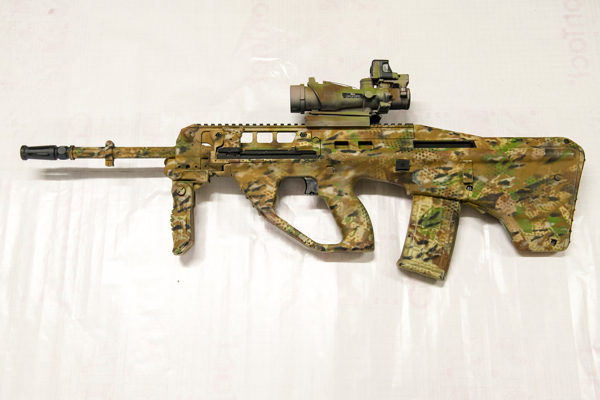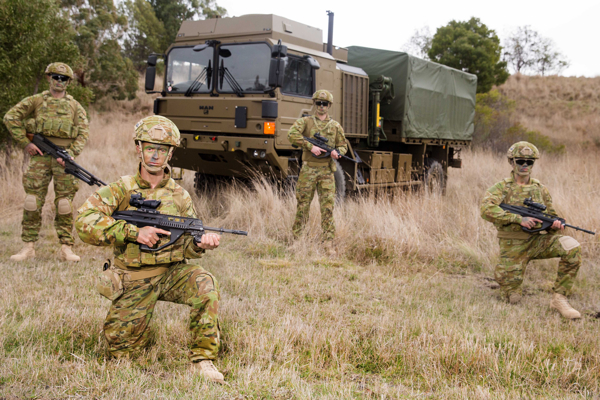The first of 30,000 new EF88 service rifles have been issued by the ADF in parallel with the rollout of a new Soldier Combat Ensemble (SCE) comprising load carriage equipment and protective kit that includes new-generation body armour, combat helmets, and hearing and eye protection.
Julian Kerr | Sydney
Some 700 EF88s from the low rate initial production activity approved by government in September 2014 were issued in June to Townsville-based 1 RAR for derisking activities.
Under Project Land 125 Phase 3C, which received government approval in 2015, over the following five years the EF88 (E for Enhanced) 5.56mm rifle will replace the Austeyr F88 which, with various modifications, has been in service with the ADF since 1988.
Meanwhile the first issues of the SCE, under development for the past five years under Project Land 125 Phase 3B, took place in May to 7 RAR in Adelaide, elements of 1 Brigade in Darwin, and to RAN clearance divers.
The SCE rollout will be completed over three years to what Defence describes as those combatants who need it most, and most often, whether from Special Operations Command, Forces Command, 2nd Division, RAAF, or RAN.
Development of a successor to the F88, manufactured at Lithgow by the then Australian Defence Industries that was subsequently purchased by Thales, was contracted to Thales in 2008.
Provisional design acceptance for the weapon, a substantial development of the F88, was received in April 2014 and second pass approval for Phase 3C expenditure of about $447 million was announced in July this year.
 Credit: Defence
Credit: Defence
About $100 million will be contracted with Thales for 30,000 rifles and an undisclosed number of integrated Steyr Manlicher SL40 40mm grenade launchers. The balance of $367 million will acquire a broad range of targeting and surveillance ancillaries, support and training aids for the EF88 system.
Army’s key requirements involved weight reduction and improved weapon balance; interoperability with NATO 5.56mm standard ammunition; improved survivability with reduced weapon signature; improved lethality with enhancement to existing Surveillance Target Acquisition ancillaries; and an integrated grenade launcher.
While Army maintains the suitability of the M4 for use in Special Operations Command, it believes the EF88 is a superior weapon for the broader Army and Air Force. This belief is founded in extensive analysis and user trials.
With the addition of its ancillaries, coupled with high quality simulation and range training, Army believes its lethality is expected to be as good, if not better, than any other assault rifle.
"Weapon lasers for the EF88 are planned to be identified by Project Land 53 Phase IBR."
The EF88 with its standard 20” barrel and underbarrel grenade launcher is around 1.63kg lighter than the F88SA2 variant of the in-service weapon equipped with the current M203 grenade launcher.
While the M203 must be fitted to the F88AS2 by an armourer, the sideloading SL40 can be easily attached to or removed from an EF88 within seconds without any tools or specialised training.
Exhaustive testing of two EF88 initial production batches saw more than one million rounds fired from the second batch of 30 rifles over seven months. Thousands of grenades were also fired from the SL40 during qualification testing, primarily practice grenades but also high explosive, high explosive dual purpose, illumination, smoke, and rubber ball rounds. Low velocity extended range and airburst munitions were also tested without modification to the rifle or launcher.
Design changes
Among numerous design changes, the buttstock now hosts a bolt release catch which obviates the need to retract the cocking handle to release the bolt group after a new magazine is inserted. This measurably reduces the time taken to reload.
A raised cheekpiece on the stock is fitted for but not with a plug-in electrical socket that can be connected to a void in the buttstock able to contain a Thales-developed battery pack. This will provide the capability when required to provide centralised power to the EF88’s Picatinny rail system and help meet Defence’s mandated requirement for future proofing.
One immediately noticeable change is in colour - the EF88 is black rather than the F88’s khaki, although repainting will be allowed by certain combatants; normally part of reconnaissance, sniper, surveillance or joint fire team organisations.
The EF88s, ancillaries and SCE variants will all be issued according to combatant tiers; a first for Army, which has traditionally focused SCE design in particular solely on the requirements of dismounted infantry.
These Tier definitions will equip combatants according to their primary operating task and likelihood of threat encountered.
Tier 0 is a basic SCE configuration specific to Land 125 Phase 3B consisting of baseline belt webbing, assault pack and ballistic and laser eye protection that is issued to all combatants.
Tier 1 is an SCE configuration for unique or specialist combatants who require highly specialised equipment for a particular role. This includes military free fall, diving and concealable systems.
Tier 2 Dismounted are combatants whose role is close combat as part of a dismounted combined arms team, including infantry, joint fires and combat engineers. They may include select signallers and other common attachments to dismounted combined arms teams; RAAF security force squadrons, and RAN clearance diving teams and boarding parties. Tier 2 Mounted comprise troops who operate armoured fighting vehicles as part of a combined arms team
 Credit: Defence
Credit: Defence
Tier 3 General Combatant comprises combatants whose role and tasks are primarily focused on providing combat support and combat service support to combined arms teams, including all corps not included in the Tier 2 definitions and select RAAF non-security force personnel.
Contingent on their role, Tier 2 dismounted personnel will receive a universal enhanced day sight; an in-line image intensifier to enable target detection and engagement by night; an in-line thermal imager to enable target detection and engagement by day/night; grenade launcher; detachable foregrip with extendable bipod legs; bipod (Marksman only); reversionary sights; and a high-powered rifle torch.
Tier 2 Mounted personnel will receive a universal enhanced day sight and a detachable foregrip for their 16” barrel carbine variants.
Tier 3 combatants will receive a universal enhanced day sight, detachable foregrip and, for grenadiers, a grenade launcher.
Weapon lasers for the EF88 are planned to be identified by Project Land 53 Phase IBR which is yet to be considered by government.
A Defence spokesperson said Army was consistently seeking opportunities to enhance the performance and reliability of its ammunition natures, but declined to disclose whether it was testing or buying the new US M855A1 or Thales F9 enhanced performance 5.56mm rounds.
In developing and refining the SCE over the past five years, every pouch, buckle, strap, harness, helmet, hearing protection and protective eyeware has been subject to unprecedented analysis, Lieutenant-Colonel Benjamin McLennan, Staff Officer Combat Development at Army Headquarters said to ADM.
This has included feedback from trials, the combat experience of both special and conventional forces and RAN boarding parties, and constant comparison against alternate leading commercial off-the-shelf options.
Whether the new SCE will restrict the opportunity for soldiers to acquire and use their own equipment has yet to be determined, but “Army has never had so much confidence that the SCE it is providing is functional, integrated, sustainable, and has the confidence of combatants”.
The SCE delivers the Tiered Body Armour System (TBAS) ballistic plate carriers in a Tier 2 and Tier 3 design.
Both provide a platform for the carriage of protective equipment, including two types of hard armour plates, one of which defeats high velocity rounds and one which defeats armour-piercing rounds; together with soft armour inserts which defeat low velocity rounds, fragmentation and blunt force trauma as well as supporting the hard armour plates.
Also included are edged blade/spike inserts which defeat piercing and slashing hand weapons as well as blunt force trauma, and extremity protection against low velocity rounds and fragmentation.
The Tier 3 TBAS plate carrier provides additional coverage of the combatant for greater protection, while the Tier 2 carrier maximises mobility.
Both tiers include Modular Lightweight Load Carriage Equipment (MOLLE). This allows the attachment of other role-specific pouches directly onto the plate carriers; apart from protection capability the primary differential between the various elements of Tiers 2 and 3.
The initial Tier 2 Combat Helmet provides protection against fragmentation and blunt force trauma while providing maximum levels of integration and weight reduction. The Tier 3 combat helmet also provides protection against fragmentation and blunt force trauma, involving a different balance between weight, integration and protection.
The initial Tier 2 combat hearing protection uses an over-ear protection system and external microphones to enable active listening, and also integrates with service radios, providing an increased level of situational awareness. The existing ballistic and laser eye protection system is being incorporated in the SCE.
“Operational feedback/lessons learned have validated the level of protection afforded by Land 125 Ph3B and the need to allow combatants and their commanders to up/downscale their level of protection according to mission,” LTCOL McLennan stated.
The Army Reserve’s multi-role battlegroups, which provide force generation alongside each of the Regular Army’s three combat brigades under Plan Beersheba, will receive the SCE during the ensemble’s three-year rollout.
“Army is very serious about providing SCE to those who need it most - including those from the 2nd Division,” LTCOL McLennan commented.
Spiral development compels Army, Capability Acquisition and Development Group and other stakeholders to constantly scrutinise the design, functionality, integration and ergonomics of the SCE being delivered.
“I expect key future developments in SCE will include lighter, and perhaps hybrid, protective equipment and a Tiered Combat Helmet; more functional load carriage equipment that optimises the balance between protection, load carriage and mobility; and improvements/adaptations in order to maximise integration with emerging projects,” LTCOL McLennan forecasted to ADM.





